STAR WARS: Legion Refresh Deep Dive
07/18/2024
In this transmission, The Star Wars™: Legion Development Team shares an in-depth look at the updates and upgrades for the general rules, objectives, movement, and more for the new rules refresh.
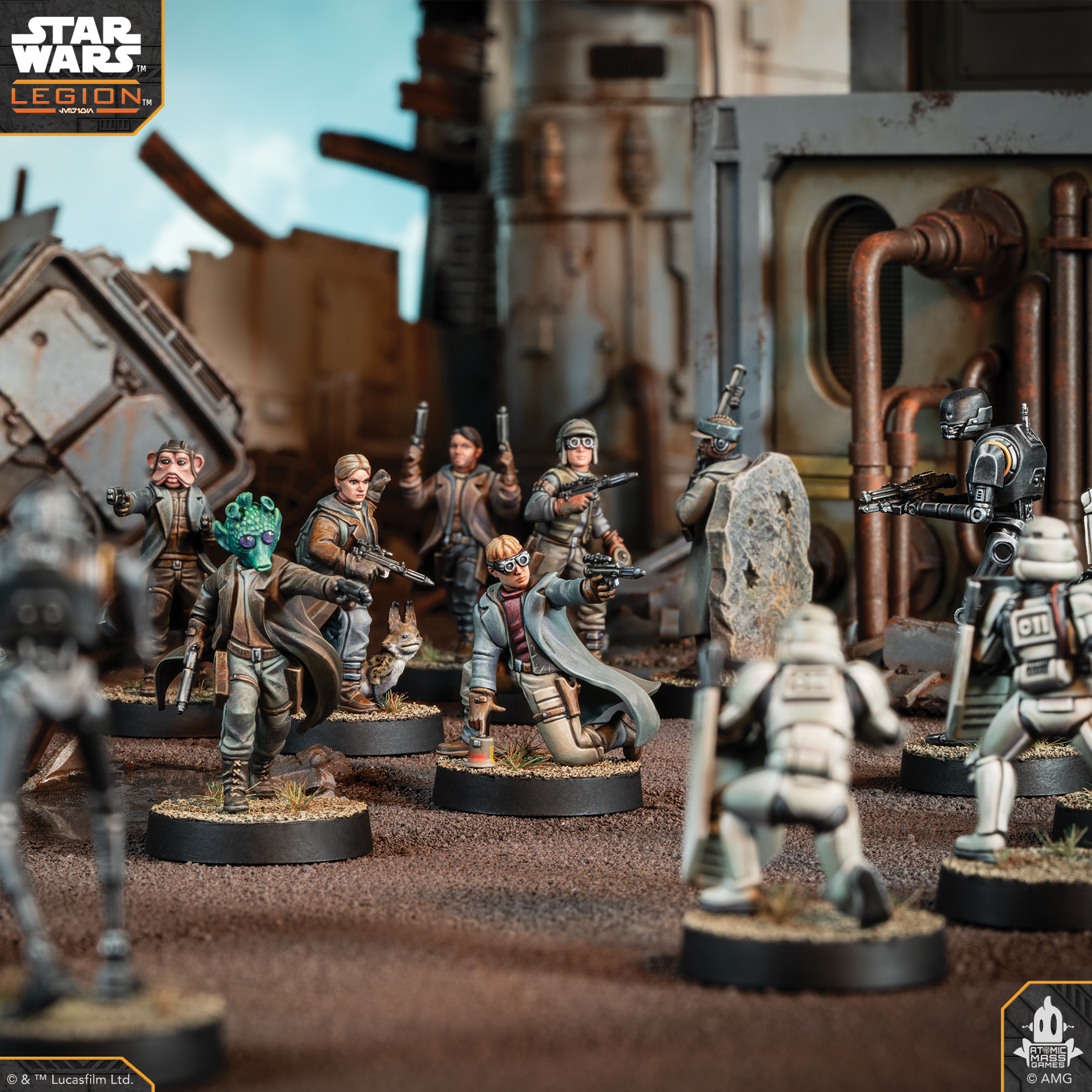
General Reasoning
Our goals with these rules updates to Star Wars: Legion are to address several facets of the game:
- Complexity
- Units: Uniqueness and Roles
- Scenarios and Missions
Let’s talk about complexity first, as this topic informs and guides the rest of the changes. The core gameplay of Legion is easy to learn—it takes well-known mechanics, and it uses them well to portray battles taking place in the Star Wars galaxy. As the game has aged and continued to grow, many things have been added, including rulebook updates, additional factions and battle forces, and new ways to play. Throughout the years this has added layers over the core mechanics of Legion, creating a multitude of complex rules interactions and gameplay situations. Things like Transports, various movement modes for units, creature troopers, field commanders, and many other keywords or unit types have been added to these layers over the core rules of the game. One of the main goals of this rules update is to consolidate many of these layers that have been added over time with the core gameplay to create a more cohesive and intuitive gameplay experience.
By reducing and refining this type of complexity, we can usher in more exciting and thematic ways for players to engage with Legion and their collections. As you read through the changes, you’ll find that many things have been simplified or reduced in complexity to move toward this end goal: a more thematic, streamlined experience that is distinctly Star Wars.
Many significant Unit, Upgrade, and Command Card changes are also part of this update. As we move forward into the future of Legion there will be many more such updates, but for now we focused on a few areas: units that had keywords that we were significantly updating or removing, units that are underplayed, and units that were significantly affected by how the missions changed. Additionally, many characters and their Command Cards have been updated to breathe new life into them, open design space inside of the different factions, and bring distinct play styles to the armies they are included in. We also took a very close look at corps units in each of the armies and diversified them into unique roles to give them a purpose and a reason to be taken. The Galactic Republic faction, which has its own entry below, was the most affected by these updates.
The largest changes of the entire update are likely to be how players build a mission each game. The original mission system used a bidding system to determine which player’s battle deck would be used in that game.
Before we go any further into this topic we’d like to take a moment to talk about ‘bids’ and how the blue player was determined before this update—the player who ‘bid’ the most army points (meaning took the lowest total army value) was automatically the blue player. We believe that using army points to expand the capabilities of an army is more satisfying than trying to minimize the number of points spent to try and get a strategic advantage when building the mission, so we removed the incentive to minimize army points by replacing bidding with a priority roll in the new mission system.
When a player won the bid, their battle deck was used to build the mission and their opponent’s deck wasn’t used at all. That made it very probable that the mission would greatly favor the army and strategy of the player that won the bid. We have taken the idea of the original mission-building system and developed it so that both players use their battle decks instead of only one player, making the process more interactive, less predictable, and ensuring the advantage from the mission is better balanced between the players. Below, we have an entire section detailing the new mission system, its merits, and the issues we have addressed with the new system.
These are the main goals of this update, but there are many smaller changes as well—this is because changing one thing almost always has a cascading effect. So, while something may seem unrelated to these topics, it was likely changed or updated due to one of these reasons.
Cover
Cover has undergone a significant change in this update: It no longer grants a flat two-hit reduction to units benefiting from it. Instead, it gives an additional chance for units to roll defense dice to reduce incoming hits. A bit of a warning: In this section we’re going to get technical and go into some of the math of attack pools, cover, unit degradation, and how that affects the game as a whole. For those math wizards out there, note that we will be using rounded numbers for ease of discussion—so please take the exact nature of this with a grain of salt!
Let’s talk about attack pools and the probability of success in both the original cover system and the new cover system. For this example, we’ll use the attack pool of a Rebel Trooper unit with the DLT-20A heavy weapon. Before any casualties, that unit rolls 6 black attack dice and 1 white attack die and adds Critical 1 to the attack pool. The average number of hits rolled with this attack pool (with no aims or anything else added) is in the 3 to 4 range. Once we account for the very common heavy cover, we’re down to 1 to 2 hits, therefore 2 saves on the unit (once again, not counting dodges or other outside sources that could reduce this further). That means the Rebel unit likely defeated one miniature from a target with red defense dice. Not a particularly exciting attack but, with some aims or other synergies, that unit can get more hits through to try to beat the flat cover system. To keep things simple, let’s start degrading this unit—meaning it’s now been attacked and has lost miniatures. At just one miniature defeated, this unit’s average hits drops much closer to 3. At two miniatures defeated, the attack is now below 3 expected hits. With cover removing a flat, non-scaling 2 hits from any pool, this unit’s offensive output becomes largely irrelevant for in-cover shots after losing even a single miniature. If the unit has lost two or more miniatures, it is likely not even worth attacking units that are in cover, thus majorly limiting the available units for it to attack.
If we now look at the same idea with a scaling, dice-based cover system we can see what that looks like: A unit in heavy cover rolls a white defense die for each incoming hit and can cancel those hits on a block or surge result, or 1 in 3 on the white defense die. Our original 3–4 hits, on average, will see about 1 hit canceled here, rather than the previous 2 for heavy cover. When the unit starts to degrade (that is, lose miniatures), we’ll see a significant difference in what happens: Even at just 2 hits (just the unit leader and DLT-20A remaining in the unit) you’re now looking at making the target unit make 1 or even 2 saves after cover reduces the hits.
Because this new system scales with the number of incoming hits, we can make some observations: Smaller dice pools are far more dangerous than they were in the original system. Cover no longer flat cancels these attacks, allowing units that have seen casualties to remain relevant in the fight longer and not lose as much effectiveness as they would have under the previous system. Very large and consistent dice pools are affected significantly more than they were under the previous system. Some rough math and rules of thumb for this new system: Until your attack pool has achieved 6 hits on a unit, the new cover system will end up with higher chances of casualties in the target unit. Once you hit 6, it’s about the same. Once you surpass 6 hits in your attack the cover becomes more relevant versus your attack pool. This is very relevant with the new larger unit personnel upgrades discussed in detail below!
Let’s talk about the implications of this change. Currently, low dice pool units without high probabilities of critical results or the Sharpshooter keyword have a very low chance of causing wounds to units in cover. This is no longer the case—the value of these attacks has increased dramatically. You’ll see this reflected in many of the points and unit changes found in this update. Very large dice pools are not nearly as effective as they were previously. Before this update, large attack pools with lots of aims could overwhelm the flat 2-hit removal from cover and push through significant damage. Now that cover scales with the amount of hits (meaning a single hit scored has the same probability of being blocked no matter how many total hits are in the attack pool) these large, hyper-consistent attack pools no longer need to be built around to cause wounds reliably. This opens significant design space in what units can do and what types of keywords units need to be effective in combat.
Another effect of this change is a significant increase in variance inside the game. Because the previous system was static—always reducing either 1 or 2 hits depending on your cover type, it was very predictable and easy to plan around. This new system of rolling defense dice for cover allows for a wider range of outcomes. We prefer this wider range of outcomes so that the results of each game don’t feel predetermined. That unpredictably adds tension and excitement since either player could benefit from it at any moment. For a player to succeed, they must make flexible plans to try to take these swings into account and adapt their play when those swings occur, just as commanders in the heat of battle are constantly required to do.
Squad Upgrades
The vision of Legion has always been of large armies clashing on battlefields across the galaxy. It is for exactly this reason the game was named Legion! This update introduces squad upgrades in the personnel slot to many corps units, increasing their unit sizes significantly compared to before the update. Not only do these bolstered units look impressive on the battlefield, they also pack quite a punch! These upgrades drastically increase the unit’s durability and offensive output.
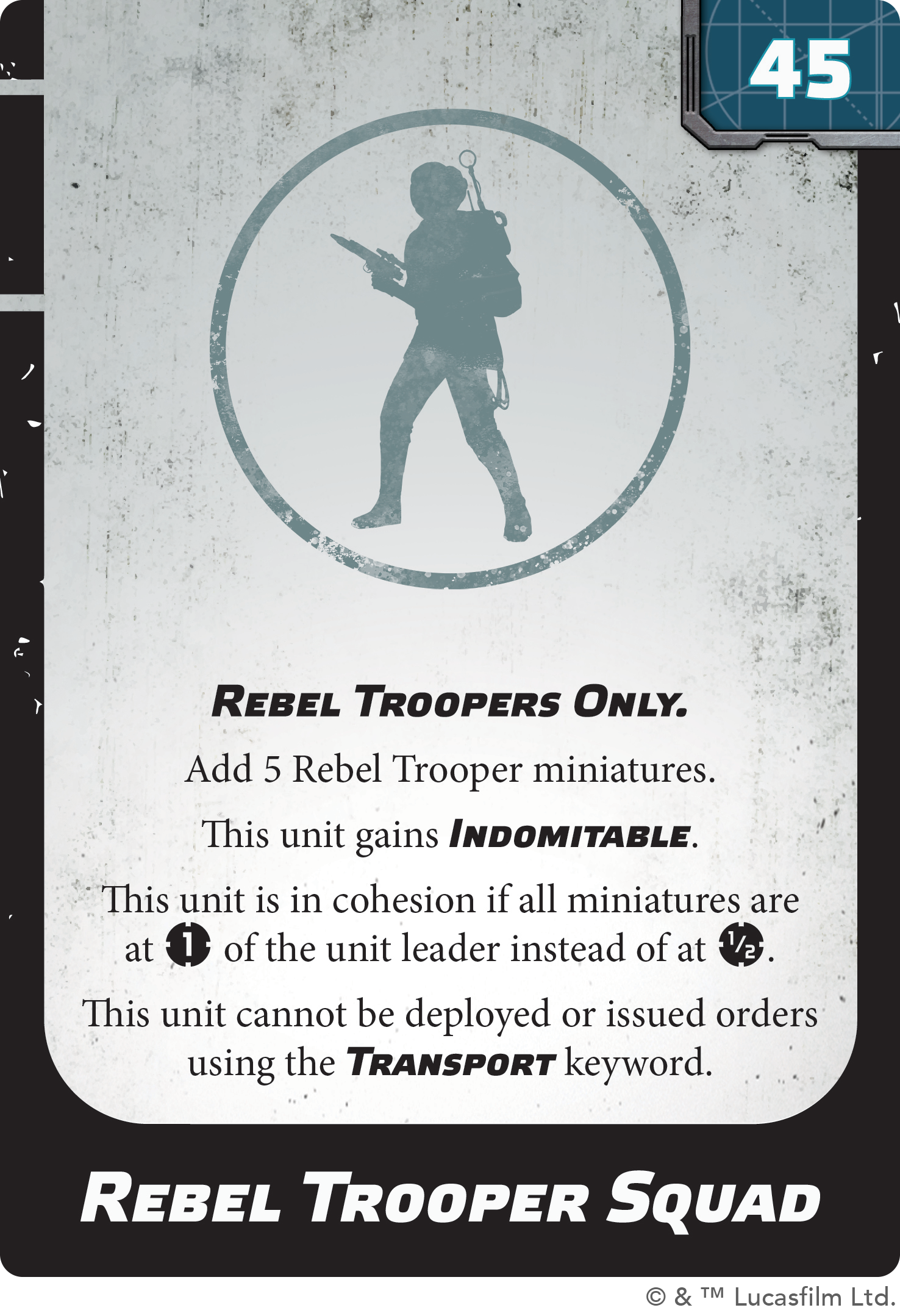
These larger units find an excellent home controlling and contesting Points of Interest in the new mission system, and their increased offensive potential is kept in check by the new scaling cover system. These larger corps units can serve as an elite element in a player’s army, concentrating the power of support and orders issued to them. There are many other advantages (and
disadvantages) to explore for larger unit sizes, but we’ll leave those to the players to find and enjoy!
Characters
Making sure players are excited to put their favorite character in Star Wars: Legion on the battlefield is a high priority for us. When we started playtesting at 1,000 points, characters were being attacked and defeated with greater frequency. To keep characters in the fight longer, we introduced a new rule called backup. While a character is defending against a ranged attack from beyond range 2 and while that character is next to a unit providing backup, 2 hits are canceled in the attack pool. In addition to backup, we wanted our lightsaber-wielding characters to have options to be more aggressive, so we changed Deflect to not require a dodge token.
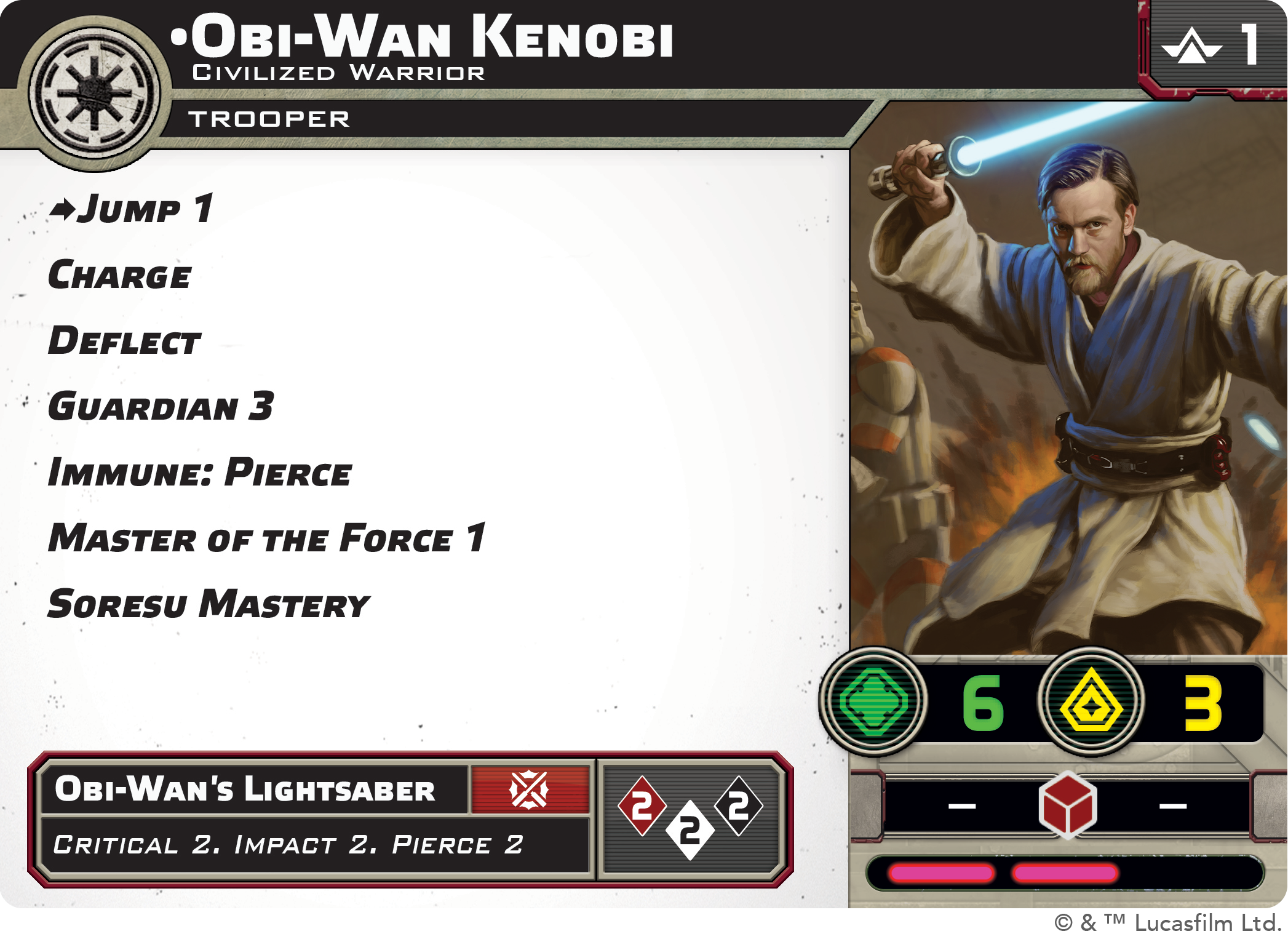
When we took a focused look at characters with Force upgrade access, we found again and again that Force Push was over performing for its point cost, and the characters that could use it every round were over performing on a consistent basis. We decided to adjust the points cost to reflect that, and Force Push has been increased to 40 points. With that change, we were able to reduce the price of most of the characters with Force upgrade access by 20 or more points.
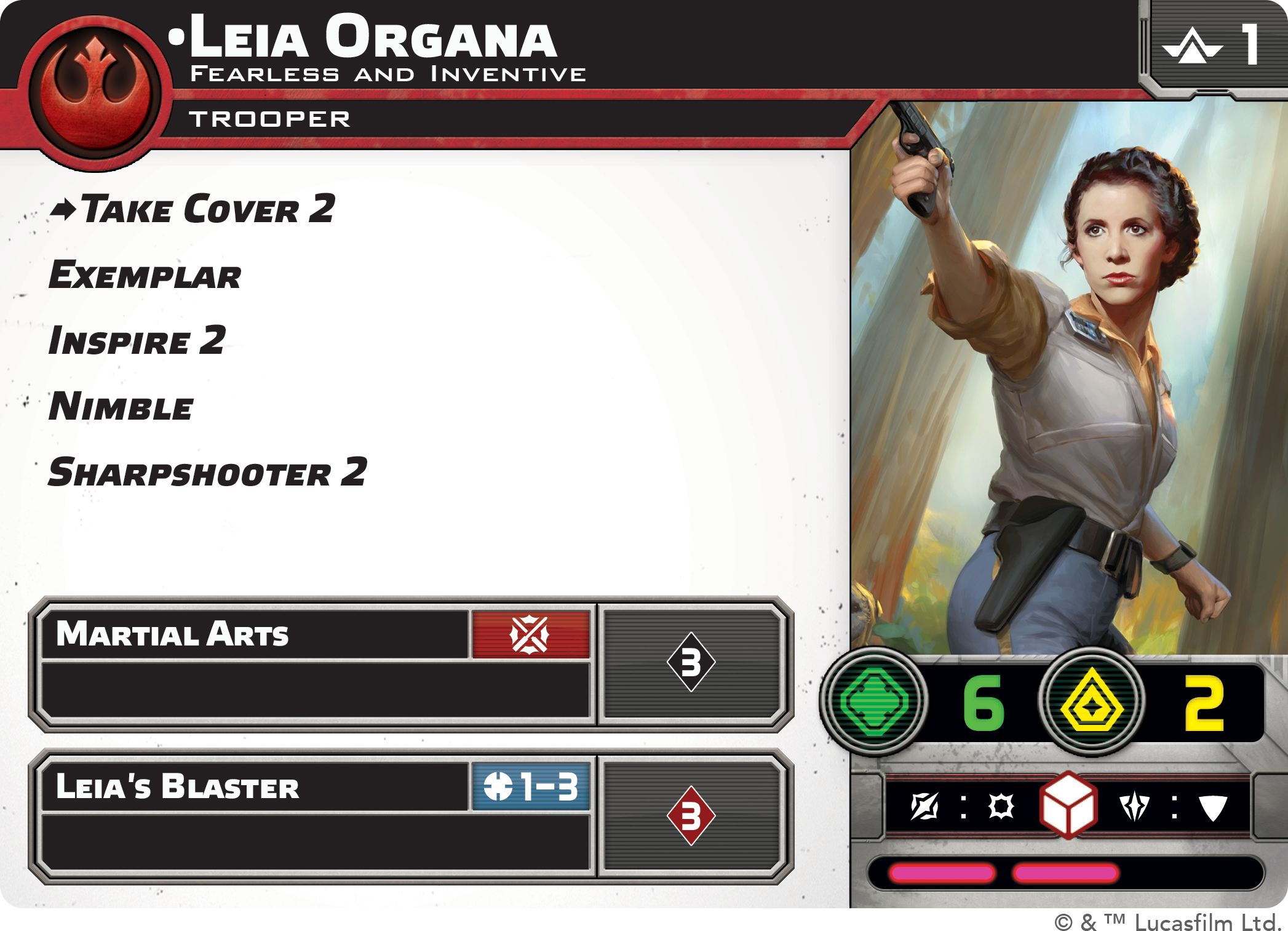
While looking at characters focused on providing support to their armies, one faction stuck out as clearly better than every other: the Galactic Republic. The token-sharing abilities in the Republic faction were just working much better than in any other faction. We decided that other factions should have a similar support mechanism, so we added Exemplar to one or more characters in every other faction. The flexibility of the support that Exemplar offers is intuitive to play with, effective, and has allowed those factions to feel more like cohesive armies.
Republic
The Galactic Republic’s play pattern of clustering around each other to share as many tokens as possible didn’t align with our vision for the faction. Instead, we wanted to emphasize the distributed mutual support among clone troopers. To do that, we increased clone trooper token sharing to range 2 and removed Exemplar from the characters in the faction. With this distributed support, Republic forces have a much easier time spreading out to play the new missions.
We also wanted to show clone trooper units as cohesive elite forces that have access to the best training and gear. To do that, we replaced Phase I and Phase II clone trooper units with a new profile. Phase I clones did not feel like the elite forces we wanted them to. Phase II clones were too expensive to build around. By merging these units into a single profile, Clone Trooper Infantry, we were able to create a cohesive baseline to build the faction around. Now, an astute reader may notice that the upgrades for Clone Trooper Infantry also mention Clone Trooper Marksmen—this is a brand-new unit coming in the not-too-distant future that wields DC-15 blaster rifles instead of the familiar DC-15A . . . and they pack quite a punch! We’re not here to discuss those today, but stay tuned!
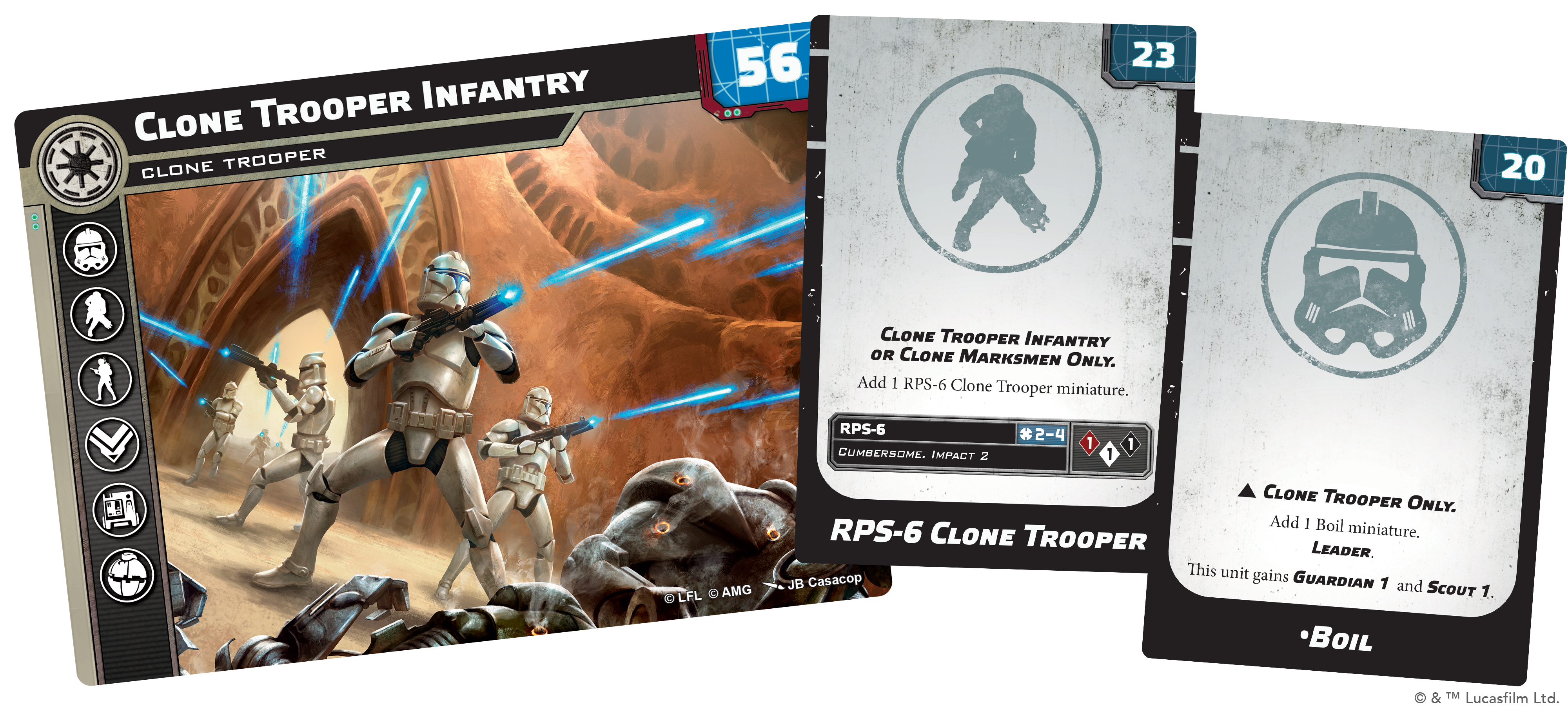
Clone trooper infantry are highly customizable units. They get access to a new type of upgrade available exclusively to the Republic: squad leaders. All the previous personnel upgrades with the Leader keyword are now squad leader upgrades. Clone trooper infantry also have access to all the upgrade slots Phase II clone troopers had in addition to the squad leader upgrade,
making them the corps unit with the most options available to them. The squad leader upgrade will also allow us to show the clone support of Jedi more directly by incorporating Jedi into units of clones, like the upcoming Jedi Guardian that can be attached to the clone trooper special forces units.
Additionally, we have removed Fire Support as a built-in keyword for clone trooper corps units (and changed the Fire Support keyword altogether). The play pattern encouraged by Fire Support was to add more dice to the highest-quality weapon possible to “filter” those dice through a better weapon. We felt that this play pattern pushed players toward including specific units to combo with Fire Support and forced us to balance units around this possibility, limiting the types of units that could be made available to the Republic.
New Missions
The mission system has been completely overhauled in this update. Gone is the old battle deck—we’ve made eighteen new Battle Cards to use instead. These new missions are designed with progressive scoring as the primary way to win: scoring Victory Points (VPs) throughout the game instead of mostly at the end of it. With progressive scoring, players need to move their armies across the battlefield earlier in the game to fight for objectives instead of only having to move aggressively in the last round or two of a game. This incentive to push forward leads to more action taking place sooner than ever before.
Many of the changes we made are aimed at making the game feel more engaging and satisfying from start to finish. At the end of any round, if a player has 12 or more VPs, they win the game. We also decreased the number of rounds played in a game from six to five. Both these changes push the action to start sooner and make it more likely that conflict between armies will continue happening throughout the game. The changes to cover have made the game more deadly by allowing small units to continue to contribute damage and every activation feels more impactful as a result. Additionally, we increased the size of armies from 800 to 1,000 points and allowed some increased unit sizes so that the game feels like two full armies clashing. Even with this increased army size, the game takes less time to play than the current version. Packing more action into less time could have made the game feel more chaotic, but the clear goals given by progressive scoring are an easy beacon to follow to make sense of the game and plan your moves accordingly. We’re excited for players to get their hands on what we’ve done.
The new process for building a mission involves combining an Objective Card and its paired Map Card, a Secondary Objective Card, and an Advantage Card for each player.

Each player brings a deck that includes three of each of the three types of Battle Cards: Objective, Secondary Objective, and Advantage. The blue player, determined by the winner of the priority roll, chooses whether to randomly reveal a card from their Objective or Secondary Objective decks, while the red player randomly reveals a card from their deck for the other type. Each player then reveals an advantage from their deck of three Advantage Cards. Starting with the blue player, players then take turns modifying the mission until each player has modified the mission twice. Players can modify the mission by replacing any card in the mission except their opponent’s advantage with a card randomly selected from their deck of the same type. Players can also use their turn modifying the mission to become the blue player so that they can choose their table side after the mission is set. Unlike the old mission system, both players’ battle decks are used. This makes the mission system more collaborative and less predictable. While the starting blue player may begin with the upper hand in building a mission, the starting red player has the clear advantage of getting to modify the mission last. In practice, this means missions often end up with distinct edges for each player that they will have to make the most of to win.
The goal of Objective Cards is to be the primary influence in determining where units need to be over the course of the game. Each objective’s map shows player territories and Points of Interest (POIs). POIs are 2-inch tokens that units must secure by ending a round next to them to score VPs. A player’s territory shows where their units can deploy, but units no longer deploy before the game starts. Instead, normal units deploy during their first activation of the game by using a move action.
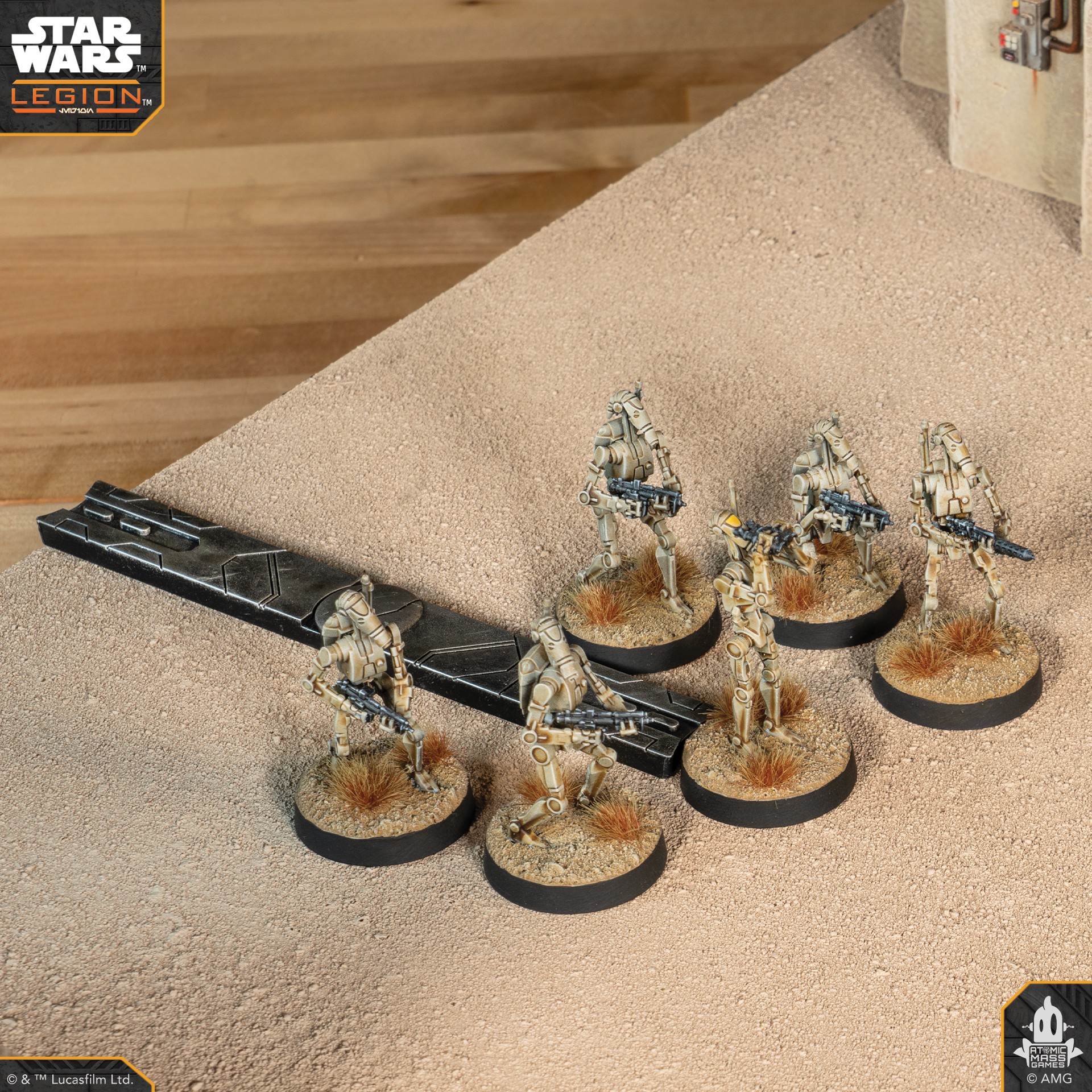
When the blue player’s unit uses a move action to deploy, the movement tool is placed so that one side of it touches the battlefield edge in the blue player’s territory. We made this change so that the deployment process would be more flexible and directly interactive. Instead of having a deployment phase after building a mission, players jump right into activating their units, can counter deploy, and hold activations and deployment to create very interesting strategies and gameplay.
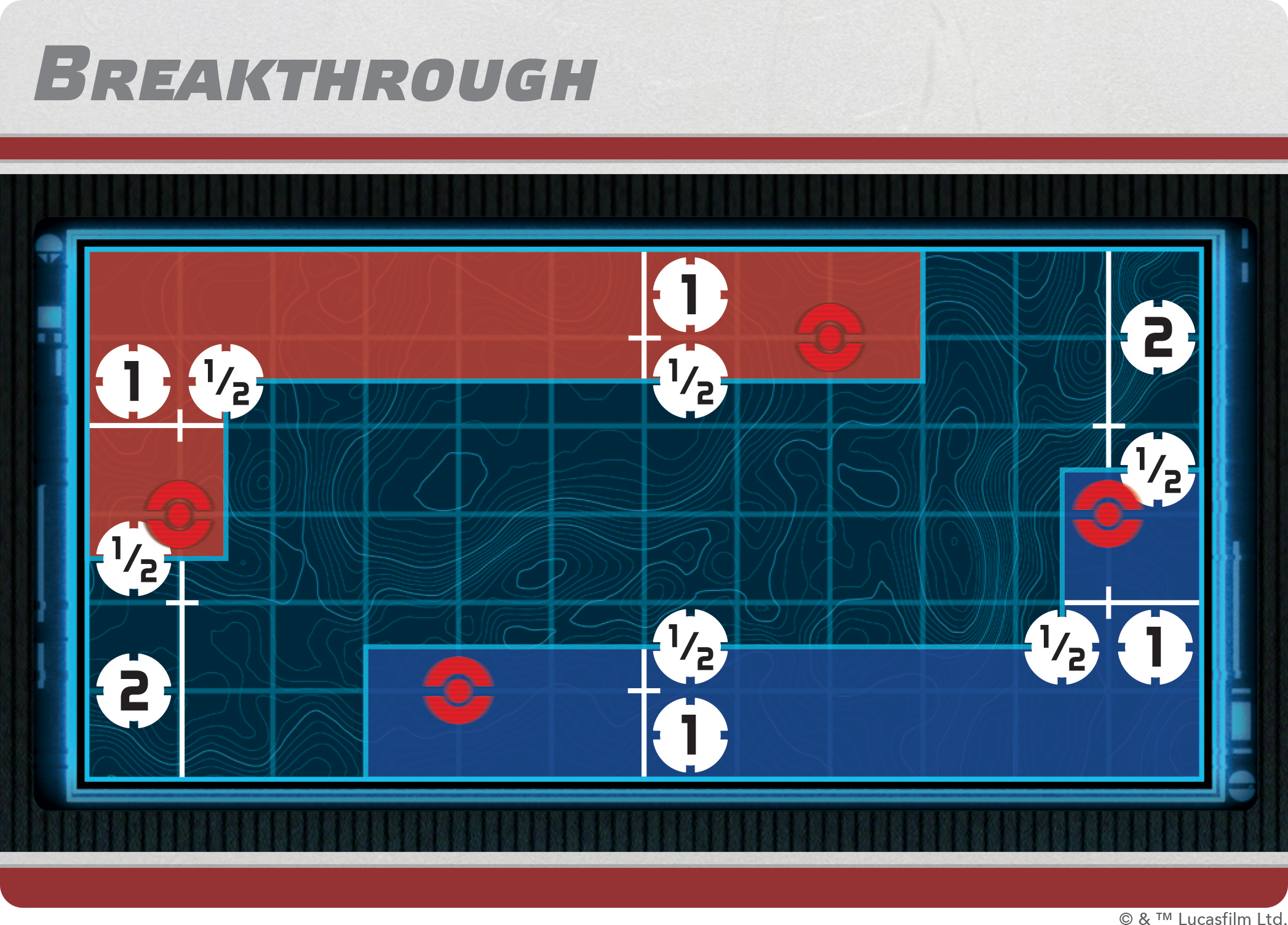
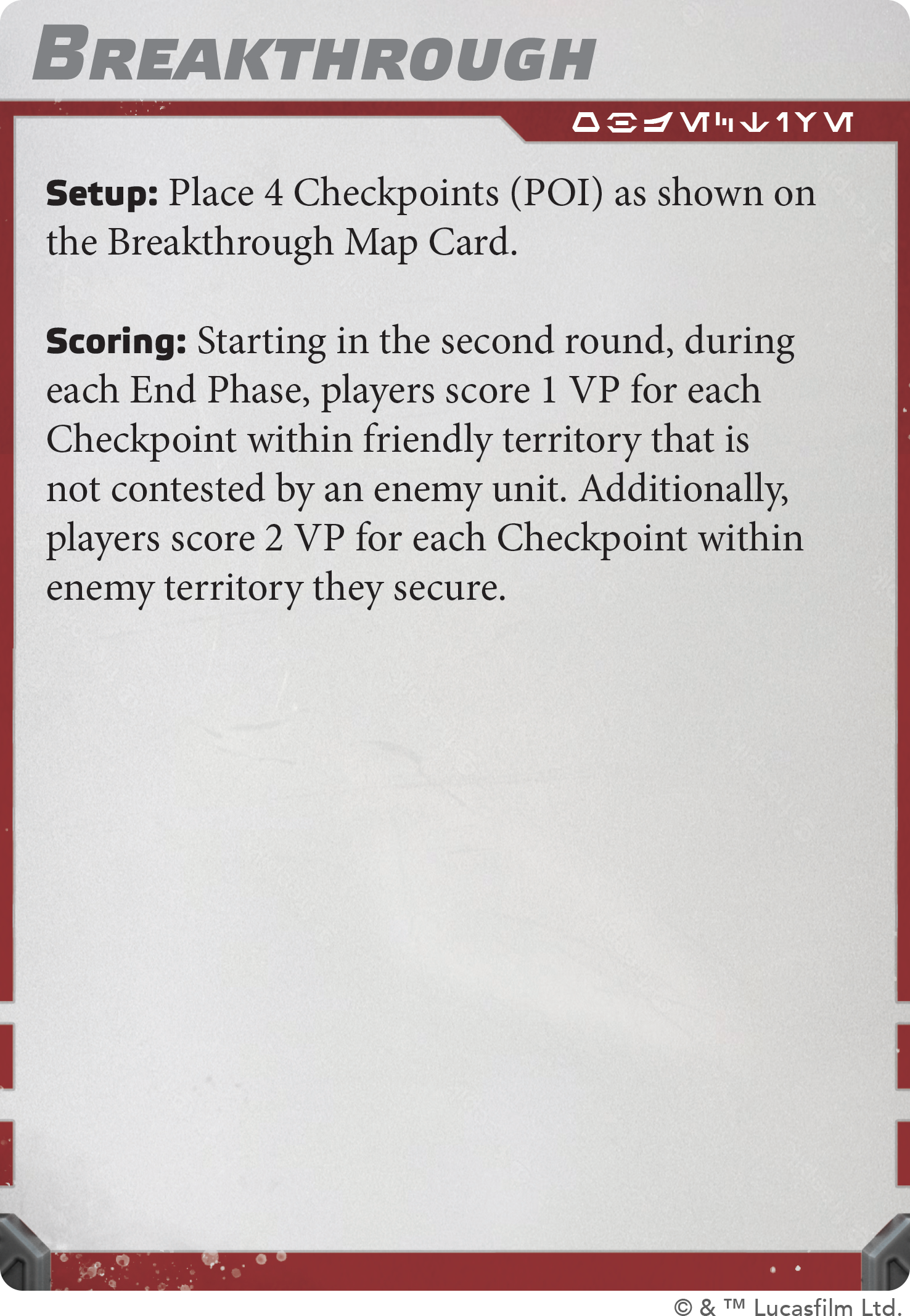
Comparing the maps for Breakthrough and Intercept Signals (Shown in the rulebook excerpt above), you can see that the shape of the battle will be very different. In Intercept Signals, the action of the game is focused on the middle part of the map, so a durable and aggressive unit can often have an outsize impact by threatening the most important areas of the battlefield from the center of the table. In Breakthrough, play is often split on both sides of the map, rewarding fast or long-range units that can contribute to both sides. Aggressive units are still useful in Breakthrough, though, since they can use that aggression to force their way to the POIs in their opponent’s territory. Fast-moving units in Intercept Signals can use the open sides of the board to make flanking maneuvers and get around enemy forces unimpeded. Different Objective Cards reward different play patterns, types of units, and play styles. A broad selection of Objective Cards gives players many ways they can adapt their strategy to any given situation in hopes to gain an advantage and claim victory on the battlefield.
While Objective Cards largely define where the fighting is focused and set the scene, Secondary Objective Cards give players additional goals to accomplish. Bring Them to Heel focuses players on giving suppression tokens to enemy units and removing them from your own units. Keywords like Inspire and Suppressive have an increased importance when playing a game using Bring Them to Heel, and the recover action becomes more immediately relevant. These shifts, in which choices are most effective, help make each game feel different from the next and require players to adapt their play patterns accordingly. Secondary Objectives often have once-per-game goals on them. Bring Them to Heel awards players 2 VPs for getting a suppression token onto each enemy unit that can have them. While challenging, it’s often possible in the late rounds of a game if a player shifts their focus and stretches to get it done. These kinds of stretch goals give players a way to abruptly swing the outcome of a game, if they can spot or create an opportunity to accomplish them.
Advantage Cards live up to their name: they give players a strategic advantage they can use in that mission. Garrison represents a corps unit stationed at the site of the impending battle; it allows a unit to start the game deployed inside a player’s territory with a dodge token instead of moving onto the board, getting them into the fight faster. Advanced Intel represents scouting out the enemy before the fight, and it gives that player the ability to pass an additional time in round 1 by giving them a pass token. Passing is often very important in round 1, since it gives a player more information on where the enemy forces are before they need to deploy a unit.
We found passing was so important in round 1 to get a fair fight that we changed the way passes are handled. During the Command Phase, the player with fewer units gains pass tokens equal to 1 less than the difference in the number of units each player has. If a player has 7 units, and their opponent has 10, they gain 2 pass tokens that round. A player can spend a pass token to pass instead of activating a unit on their turn if they didn’t pass on their previous turn. Changing passing in this way makes it so that a player rarely activates more than 2 units in a row, preventing players from exploiting large differences in activation counts and giving the game a more even back-and-forth feel.
Movement
More than ever before, the new missions require units to get to locations spread across the battlefield, so we took a close look at how units move. We encountered two main problems that needed to be addressed: very fast armies were too powerful and units grouping up around objectives caused movement around those objectives to be severely limited.
In early iterations of the missions, most mission scoring started in round 1. That led to a blitz style of play where every unit needed to move as far and as fast as they could, and units that could get to the objectives sooner had an extreme advantage over slower units. Moving scoring to round 2 gave players time to focus on deploying units in positions where they could have continued and prolonged success instead of having to push them up the field as quickly as possible. Even with the change to round-2 scoring, the fastest units were over performing since they could start attacking and contributing to scoring objectives far sooner, so we had to rein them in. Most of the units with the Speeder X keyword increased in points. Infiltrate changed to deployment within that player’s territory instead of beyond range 3 of enemy units. Transport changed to an alternate deployment used at the beginning of the game instead of allowing units to be carried all the way across the battlefield. With all those changes, the army strategy of blitzing across the battlefield as fast as possible is still a viable plan but is no longer above the curve.
In testing, units were having some trouble moving in the sometimes heavily congested areas around objectives. Also, notched-base miniatures were creating repeated issues around objectives due to displacement. We determined that we needed to remove displacement from the game to create the gameplay around objectives we wanted, and we knew we also needed to overhaul notched-base movement in general. First, we made it so all units can move over all other units to prevent the denial tactic of clogging up objectives with miniatures. We also incorporated a 90-degree rotation at the beginning of every notched-base movement so that those units always have the option to move in other directions. Notched-based units weren’t the only units having trouble moving, though. We changed regular movement to place the unit leader in contact with any part of the movement template to give extra flexibility to movement in congested locations. Finally, we noticed units got engaged much more frequently due to the need to move next to objectives. We changed withdraw to only require one action but prohibited performing attacks, standby actions, or engaging other units during an activation in which a unit withdrew.
Thanks for joining us for this closer look at the upcoming changes for Star Wars: Legion! We hope this answers some of your questions. Be sure to check back for more previews of upcoming products, and see what items are available for pre-order or purchase through your local game store or through the webstore.
Until next time, Atomic Mass Games signing off!